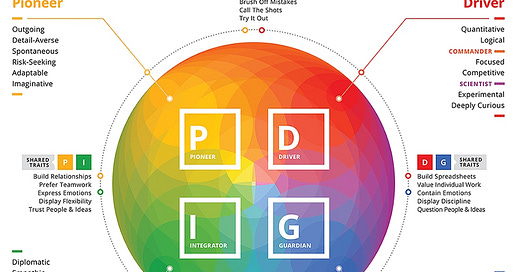#26 - How to Assemble Kickass Teams Leveraging Business Chemistry (Five Tactics)
Sharing one of the most valuable tools I learned & applied constantly in management consulting at Deloitte
Tl;dr — you must be intentional about team construction, and I find that using this simple work personality framework, “Business Chemistry”, has been helpful to assembling teams that work together well. Simply throwing people into a team together and being optimistic is not enough.
Back when Barack Obama was getting ready to start his first presidential term, there was a bunch of focus on his approach to building his cabinet, a team of rivals approach that would ensure diversity of perspectives and also personality types.
Fast forward 5 years, and I’m starting the management consulting stage of my career and going through literally five straight weeks of classes and training (one taught my an ex-NASA launch engineer on how to reduce risks in complex projects, mega cool). It was in these classes that I was first introduced to a super elegant framework for understanding personality types at work: Business Chemistry. Full disclosure: this is a Deloitte IP, and it is so.good. I still have the HBR article that explains this all in great detail.
The Business Chemistry (herinafter “BizChem”) Framework
What you’re seeing above is basically saying…
Pioneers embrace risk to create new futures. They imagine the future.
Integrators connect various types of people together. They are connective tissue.
Guardians create structure, embrace details, and tend to be more skeptical of change.
Drivers drive work forward. They are competitive + prone to identifying roadblocks and then dismantling them.
If you prefer videos for learning, go to this site
Cool, Michael, what the hell do I actually do with this framework? Four tactics for you :-)
Knowledge on its own isn’t power. Knowledge applied to your actions is what creates power. And this framework can be very powerful, if you follow some of the below guides:
Before you assemble a team, use this tool for each person and your own judgement) to ensure that the mix of personalities and bizchem traits are going to be in relative balance — that is, that you will have some representation of each personality type
Once you’ve assembled the team, orient people to the framework, give them quiet time with it, and then ask them what they think they are. Have them talk about why they think they are a certain type, and to provide examples of past experiences that validate their perspective
Be vocal about the importance of different ways of thinking / different bizchems. “Team, the only way this project is going to work as the complexity increases is if we’re all able to bring our strengths to the table. The pioneers need to be counterbalanced by the guardians. The drivers need to partner closely with the integrators, and the integrators need to help make sure our collaboration foundation is always fertile. If you aren’t explicit in showing appreciation for different types of thinking, you may find people becoming alienated
Common example: a team of five people has
Driver
Driver
Pioneer
Guardian
Driver
In the above team, how do you think the guardian is going to feel? It’s your job as a teammate or team configurator to ensure that the guardian is included, empowered, and respected
During 1-1s and/or retrospectives, ask people about the moments that felt empowering and energizing, and the moments that felt stifling or frustrating. It takes time to do this, yes, but you’ll both / all learn about interpersonal dynamics. Teamwork is a mindset and a muscle, and working as a team takes practice. We all need feedback and tuning to make sure we’re getting better at collaborating with others.
As a personal aside, my bizchem changed pretty strongly over time, and many folks I worked with over the years also experienced fluctuations as they worked in more teams, got more feedback, learned new ways of working. I think changes in how we operate are a part of evolution…
And the roles you have may demand more of one type of characteristics than others. In 2013, I had almost 0% driver in me. By the end of 2017, I was 30% driver. Today (mid-2022), I’m probably 20% driver. These fluctuations reflect evolution over time as you learn new ways of working from people who are different than you. And yes, this also means occasionally learning that a particular way of working is NOT your style and NOT compatible with how you do your best work.
Which leads me to tactic #5
In appreciating what you do NOT want to be like at work, you can start to hopefully reframe unpleasant/frustrating work experiences as data that can help you ensure your future teams work for you, too.
For example, if you uncover that you really do not like project managers who constantly bug you for updates / micromanage, then you can come to your next opportunity and say,
“I’ve learned that being pinged for daily updates makes me feel constrained and unnecessarily anxious. I do my best work when we have updates a couple of times per week at set intervals, where I can actually write out my updates in quiet first. Can we construct our project management cadence in a way that takes this...regularity and predictability into account?"
And hell, no need to wait until your next project. Having a 1-1 where you ask for patience as you share your feelings with a current colleagues is a key part of high-performing teams (probably going to write a separate letter on having productive, emotionally-dicey conversations at work). You do have the power to change what’s happening Now, too.
Michael
P.S. I am not compensated for any of the links to products or services I talk about in my letters. If I’m putting it in here, I just find it to be useful




Using this for sure. Thanks for sharing!